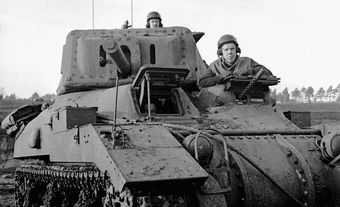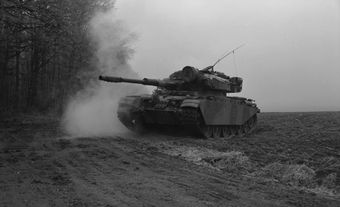The American M4 Sherman medium tank is one of the most famous tanks in history. It became the most widely used tank by the Western Allies during the Second World War. Its fame was due to its many inherent qualities and the large numbers that were produced. The Sherman went through many upgrades and numerous specialized variants were designed. After the war, it continued to be used for several decades.

Development
The fall of France in June 1940 after a short German blitzkrieg (“lightning war”) campaign shocked and surprised the United States. American leaders quickly realized they needed a new tank that could fight German ones. In July 1940, the War Department approved the development of a new tank. The result was the M3.
To get a new tank into production quickly, the M3 had its 75 mm main armament gun mounted on the right front side of the hull. The gun was limited to a 30-degree traverse, which severely limited its ability to quickly engage multiple targets on the battlefield. Although a fully rotatable turret was preferred, it was beyond American industrial capacity at the time. Eventually, 6,258 M3s were built by late 1942. The British bought more than 2,855 M3s. In British service, the tank was known as the General Lee, while the modified British version was called the General Grant. (See also Ram Tank.)
The M4 Sherman evolved from the M3 and production began in February 1942. Its designers emphasized speed and mobility over armour thickness and size of main armament. Most early production Shermans’ armament consisted of a 75 mm low-velocity gun in a fully traversing turret, plus three machine guns: a turret roof-mounted .50 calibre for the crew commander, a .30 calibre coaxial one aligned with the main gun and another .30 calibre in the hull for the co-driver.
The Sherman’s frontal armour was sloped. Depending on the model, frontal armour thicknesses could range from 50.8 mm to 108 mm. Most Shermans weighed about 30 to 33 tonnes, had a maximum speed of 38 to 46 km/h and a range of 160 to 240 km. They were driven by either gasoline or diesel engines, which generated between 400 and 500 horsepower. In British and Canadian service, the Sherman had a five-man crew: commander, gunner, loader/radio operator, driver and co-driver/hull machine gunner.
Use
Designed to be mass-produced, the Sherman was inexpensive, simple to build and easy to maintain. It first entered service with the British Army in North Africa in October 1942. The Sherman was used by the US Army and Marine Corps as well as British, Canadian and other Commonwealth armies, Polish and Free French forces as well as China and the Soviet Union. It saw action in North Africa, Italy, North–West Europe, the Eastern Front, the Far East and the Pacific islands. Almost 50,000 Shermans were built.
Variants
The Sherman went through several upgrades. The main differences were based on engine type, cast hulls or welded hulls and main armament calibre.
A famous variant was the Firefly, a Sherman equipped with a British high-velocity 17-pounder (76.2 mm) gun. The Firefly was a British project to enable Shermans to defeat the more heavily armoured German tanks encountered in Normandy. The 17-pounder was an effective anti-tank gun, but due to its length, weight and recoil, it required considerable reworking of the turret and modification of the 17-pounder to allow it to be installed. Most Firefly tanks were converted M4A4 Sherman tanks. With the 17-pounder, they were officially known as the Sherman Vc in Commonwealth service. The Firefly was available in sufficient numbers for D-Day on 6 June 1944. It proved to be crucial in helping to defeat heavy German armour encountered in Normandy and afterwards. (See D-Day and the Battle of Normandy; Canada on D-Day: Juno Beach.)
The Sherman Duplex Drive (DD) tank was a standard Sherman modified to “swim” by the addition of two propellors and a collapsible waterproof canvas flotation screen. As they approached the shore, tank crews lowered the screen. Canadian tank regiments were equipped with Sherman DDs for the Normandy landings.
Did you know?
Due to the demand for tanks after the fall of France, some Sherman tanks were built in Canada. The result was the Grizzly, an M4A1 Sherman tank with a few minor modifications. Only 188 Grizzly tanks were built, which were used as training vehicles. The Grizzly found greater success in two variants, however. They were converted into the Sexton Mk. II 25-pounder self-propelled gun and into Kangaroo armoured personnel carriers with their turrets removed.
Sherman in Canadian Service
During the Second World War, Canada fielded 12 armoured regiments and two armoured reconnaissance regiments for service in Europe. They were organized into two armoured divisions and two armoured brigades. Eventually, all 14 regiments were equipped with Sherman tanks. The M4A2 and M4A4 (Sherman III and V respectively in Commonwealth service) were the standard models. They fought in Italy and North–West Europe. (See Canada and the Italian Campaign; Liberation of the Netherlands; Battle of the Rhineland.)

At the end of the war, Canada left the bulk of its tanks and other vehicles in Europe to save the cost of shipping them home. In 1946, Canada purchased 294 M4A2(76)W HVSS Sherman tanks from the United States for training purposes at a cost of $1,460 each. The 76 meant the tank carried a 76 mm gun, the W referred to the fire-resistant wet-stowage ammunition containers, while the HVSS meant the tank was fitted with the new Horizontal Volute Spring Suspension to improve ride and mobility. These Shermans were used by the regular force until replaced by the Centurion beginning in 1952 and continued to be used by the militia (see Reserve Force of Canada) as a training vehicle until the 1970s.

Between 1951 and 1954, Canada provided an armoured squadron on a rotational basis as part of the 25th Canadian Infantry Brigade for the Korean War. Although the original intention was to use M10 tank destroyers, Canada switched to using regular tanks. The Americans loaned Canada 20 M4A3E8(W) HVSS Sherman tanks from existing stocks, which were taken over by each squadron on arrival in Korea. When the war ended, all 20 tanks were returned to the Americans.

 Share on Facebook
Share on Facebook Share on X
Share on X Share by Email
Share by Email Share on Google Classroom
Share on Google Classroom



